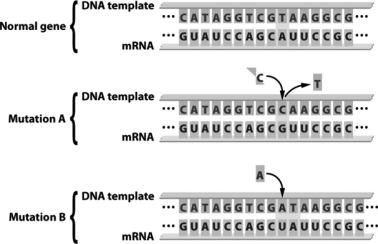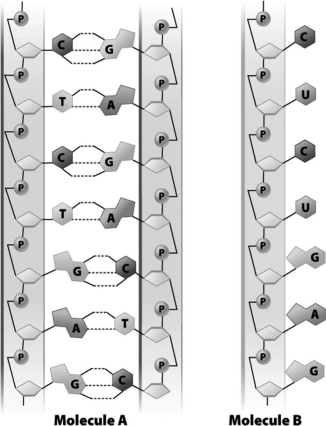A) The introns along with the exons could be used to produce the proteins the cell needs.
B) The resulting protein would be longer than if the introns were removed.
C) The resulting DNA would not code for the correct gene.
D) The resulting rRNA would not code for the correct protein.
Correct Answer

verified
Correct Answer
verified
Short Answer
Some tRNAs can recognize more than one codon because the base at the third position of their anticodon can pair with any one of two or three different bases in the codon;this phenomenon is called ________.
Correct Answer

verified
Correct Answer
verified
Multiple Choice
The following figure depicts a gene and two different ways that gene could be mutated.How does Mutation A differ from Mutation B?

A) Mutation A does not permanently change the sequence of the gene,but Mutation B does.
B) Mutation A involves the insertion of a base,whereas Mutation B involves the deletion of a base.
C) Mutation A results in a possible change in one amino acid in the protein produced by the gene,but Mutation B affects several amino acids.
D) Mutation A can only occur in introns,but Mutation B can occur in both introns and exons.
Correct Answer

verified
Correct Answer
verified
Multiple Choice
The chemical structure of bisphenol A (BPA) resembles
A) testosterone.
B) insulin.
C) estrogen.
D) progesterone.
Correct Answer

verified
Correct Answer
verified
Multiple Choice
For a firefly to glow,the enzyme luciferase must catalyze a chemical reaction in the cells of the firefly.A scientist uses a chemical to induce a mutation in the luciferase gene in a strain of fireflies.Which of the following is true?
A) Even if the mutation changes the structure of the luciferase protein,it will still be able to perform the chemical reactions needed to make the firefly glow.
B) The ability of the firefly to glow may or may not be affected by the mutation.
C) The mutation will affect the structure of the mRNA made from the gene,but not the structure of the protein made from the gene.
D) Any mutation in a gene causes that gene to stop making functional proteins.
Correct Answer

verified
B
Correct Answer
verified
Multiple Choice
A potential danger of a mutation to an organism is that
A) it can affect codons within the spacer DNA.
B) all mutations are fatal.
C) it can cause a change in the function of a gene's protein product.
D) it can increase the length of the introns of that organism's genome.
Correct Answer

verified
Correct Answer
verified
Multiple Choice
In humans,the herbicide atrazine helps RNA polymerase bind to the promoter of the gene for the enzyme aromatase.As a result
A) more RNA for aromatase is produced.
B) less RNA for aromatase is produced.
C) the production of aromatase is inhibited.
D) aromatase is degraded by other enzymes in the cell.
Correct Answer

verified
Correct Answer
verified
Multiple Choice
Which of the following is NOT a feature of the genetic code?
A) Every individual has a different genetic code.
B) Each codon in the genetic code specifies only one amino acid.
C) The genetic code is redundant.
D) The same genetic code can be applied to virtually every organism on Earth.
Correct Answer

verified
Correct Answer
verified
Multiple Choice
A promoter would be located on
A) the template strand of a DNA molecule.
B) the anticodon of a tRNA molecule.
C) an mRNA molecule.
D) RNA polymerase.
Correct Answer

verified
A
Correct Answer
verified
Multiple Choice
During translation
A) many mRNA molecules work with one tRNA molecule and one rRNA molecule to produce a protein.
B) one tRNA molecule works with paired mRNA molecules and many rRNA molecules to produce a protein.
C) strings of bonded tRNA molecules work with one mRNA molecule and one rRNA molecule to produce a protein.
D) one mRNA molecule works with several rRNA molecules and many tRNA molecules to produce a protein.
Correct Answer

verified
Correct Answer
verified
Multiple Choice
The lac repressor has been mutated so that its binding site for the operator has been altered to the extent that it is unable to bind to the operator.What is the likely effect of this mutation on the lac operon?
A) The repressor will be unable to bind to the operator;the operon will bind RNA polymerase and it will thus be turned on.
B) The repressor will bind to the operator despite the mutation,and will suppress transcription of the operon in the presence and absence of lactose.
C) The lac operon will be protected by the altered repressor.
D) The repressor will be unable to bind to the operator;therefore,the ability of RNA polymerase to bind there will be severely hampered.
Correct Answer

verified
A
Correct Answer
verified
True/False
Molecule B in the following image is RNA.

Correct Answer

verified
Correct Answer
verified
True/False
Because they are so distantly related,the codons for serine in a black widow spider would probably be much different from the codons for serine in bluebirds.
Correct Answer

verified
Correct Answer
verified
True/False
The stop codon is the sequence of bases at which transcription ends.
Correct Answer

verified
Correct Answer
verified
Short Answer
Most molecules of RNA are ________-stranded.
Correct Answer

verified
Correct Answer
verified
Multiple Choice
As transcription begins,RNA polymerase binds to a segment of a gene called a(n)
A) promoter.
B) intron.
C) start codon.
D) anticodon.
Correct Answer

verified
Correct Answer
verified
Multiple Choice
Which of the following is NOT a mechanism used by cells to reduce gene expression?
A) looser packing of DNA
B) a specific increase in mRNA breakdown
C) modification of proteins before their translation
D) stabilization of a protein so that its "shelf-life" is increased
Correct Answer

verified
Correct Answer
verified
True/False
Proteins are produced directly from DNA,with no intermediate steps.
Correct Answer

verified
Correct Answer
verified
Multiple Choice
Which of the following is true of transcription?
A) It destroys the DNA template.
B) The DNA molecule must unwind.
C) Base pairing is unimportant.
D) The end result is a protein.
Correct Answer

verified
Correct Answer
verified
Multiple Choice
The sugar molecule present in RNA is
A) uracil.
B) deoxyribose.
C) ribose.
D) sucrose.
Correct Answer

verified
Correct Answer
verified
Showing 1 - 20 of 88
Related Exams